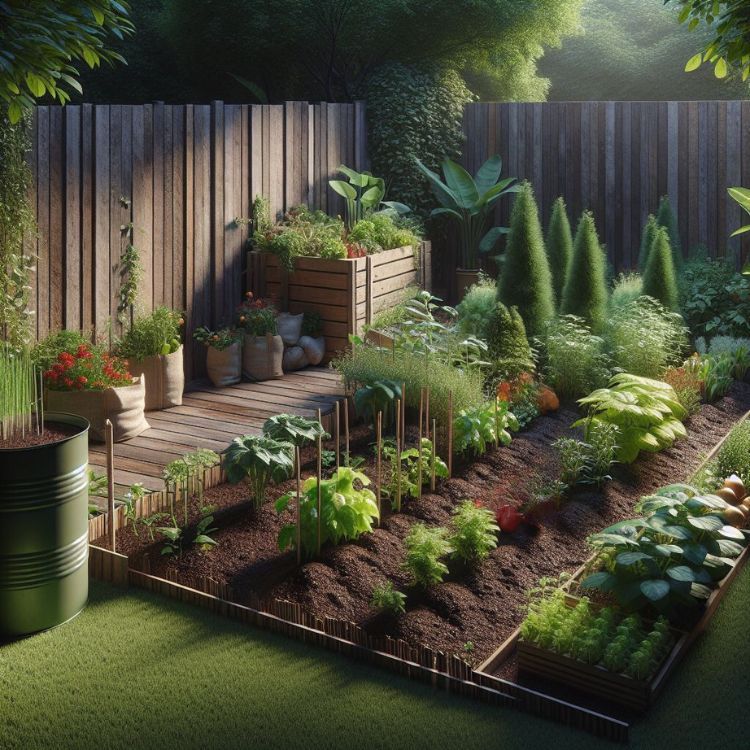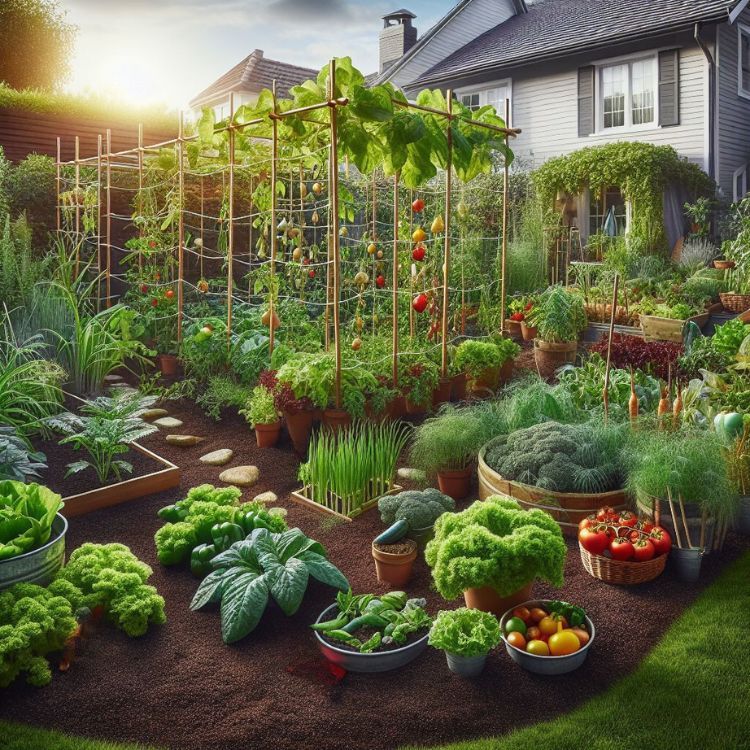
Key Takeaways
-
No-dig gardening is a sustainable method that preserves soil structure and fosters a healthy ecosystem.
-
Setting up a no-dig garden involves choosing a location, gathering materials, and layering them to create a fertile bed.
-
Layering materials like compost, manure, and straw mimics natural processes, providing nutrients and moisture retention.
-
Planting in a no-dig garden requires careful selection of seeds or seedlings and a gentle approach to avoid soil compaction.
-
Maintaining a no-dig garden is all about balance: managing moisture, nutrients, and pests while allowing nature to do most of the work.
What is No-Dig Gardening?
Imagine a garden that thrives year after year without the need to turn the soil. That’s no-dig gardening for you – a practice where you let the earthworms do the tilling. You simply add layers of organic material on top of the soil, and nature takes over from there. It’s a way to grow plants in harmony with the environment, minimizing disturbance to the soil and the critters that call it home.
Most importantly, no-dig gardening is not just about being gentle with the earth. It’s a powerful method to boost your garden’s productivity. By not disrupting the soil, you maintain its structure, which is crucial for water retention, nutrient availability, and root growth. Plus, you save your back from the laborious task of tilling!
The Environmental Benefits of No-Dig Techniques
Why opt for no-dig gardening? Because it’s a win-win for you and the planet. Here’s how:
-
Soil Structure: No-dig gardening preserves soil structure, which is vital for water infiltration and root development.
-
Carbon Sequestration: Tilling releases carbon into the atmosphere, but no-dig methods keep it locked in the soil, fighting climate change.
-
Biodiversity: A no-dig garden is a haven for earthworms, beneficial insects, and microorganisms that all play a role in a healthy garden ecosystem.
Besides that, no-dig gardening reduces erosion and runoff, keeping your soil where it belongs and out of waterways. It’s about working with nature, not against it.
Building the Foundations: Setting Up Your No-Dig Garden
Choosing the Right Location
First things first, you need to pick the perfect spot. Look for an area that gets plenty of sunlight – most vegetables love about six to eight hours of sun a day. Also, consider access to water and protection from strong winds. You’ll want a location that’s convenient for you to reach, making it easier to tend to your garden regularly.
Remember, no-dig gardens can be established over grass or bare soil, but avoid areas with persistent weeds like bindweed or couch grass, which can be a hassle to manage. For more information on dealing with such issues, consider learning about soil solarization for survival gardening.
Selecting Suitable Materials for Layering
Now, let’s gather your materials. You’ll need:
-
Cardboard or Newspaper: To smother weeds and provide a carbon-rich base.
-
Compost: Acts as the primary nutrient source for your plants.
-
Manure: Well-rotted manure adds nitrogen and other nutrients to feed your soil.
-
Straw or Leaf Mulch: For moisture retention and to keep the weeds at bay.
These materials are the building blocks of your garden bed. They’ll break down over time, enriching the soil and creating a fertile ground for your plants to grow.
Sowing Seeds and Transplanting
When it comes to sowing seeds in your no-dig garden, think of it as tucking them into a bed. You want them to be comfortable and secure. Sprinkle your seeds onto the compost, then cover them lightly with more compost or a fine mulch. For transplanting seedlings, make a hole just big enough for the roots, nestle them in, and gently pat the soil around them. It’s crucial to avoid compacting the soil, so be as gentle as a butterfly landing on a leaf. For more insight on optimizing your garden space, check out these essential urban gardening tools and accessories.
Here’s the thing: your no-dig bed is like a buffet for your plants. It’s rich and ready, so you don’t need to mix in extra fertilizers. Just give the seeds or seedlings a good watering, and you’re all set.
Watering and Feeding: Best Practices Without Tilling
Water is the lifeblood of your garden, and in a no-dig system, it’s all about consistency. You want to keep the soil moist but not soggy. Use a rain barrel to collect rainwater – it’s better for the plants and the environment. As for feeding, your layers of compost and manure are already packed with nutrients. But if you want to give your plants an extra boost, opt for an organic liquid fertilizer. Apply it directly to the base of the plants to avoid waste.
Preventing Pests and Diseases in a No-Dig Garden
One of the joys of no-dig gardening is that it naturally creates a more pest-resistant environment. Still, you need to be vigilant. Keep an eye out for any unusual spots on leaves or signs of insect damage. The key is to act fast and use organic methods, like neem oil or insecticidal soap, to manage any outbreaks.
But prevention is better than cure. By building a healthy, balanced ecosystem, you can keep most pests and diseases at bay. Encourage beneficial insects by planting a diversity of crops and flowers that attract them. They’ll take care of many pests for you.
For example, a well-placed marigold can deter nematodes, while a patch of dill might bring in the ladybugs to feast on aphids.
Rotate your crops each year to prevent soil-borne diseases and keep the pests guessing. It’s like changing the locks so the bugs can’t find their way back in.
Natural Barriers and Predators
Let’s talk about your garden’s defense system. Physical barriers like row covers can keep the critters out without any chemicals. And then there are your garden allies – the predators. Birds, ladybugs, and praying mantises are like the guardians of your garden. Attract them with plants they love, and they’ll munch on those pests like they’re at an all-you-can-eat buffet.
Most importantly, don’t forget to provide a water source for these predators. A simple birdbath or shallow dish can make your garden an oasis for these helpful creatures.
Healthy Soil, Healthy Plants
The mantra of no-dig gardening is ‘healthy soil equals healthy plants.’ With layers of organic matter and minimal disturbance, your soil becomes a powerhouse of fertility. It’s all about creating the perfect environment for roots to thrive, which in turn, makes for robust plants that can stand up to pests and diseases much better than their stressed-out counterparts.
Therefore, always be adding to your soil. Keep layering on the compost, the manure, and the mulch. It’s like continually upgrading the software of your garden to the latest version – it just keeps getting better.
Harvesting Your Rewards: Enjoying the Fruits of No-Dig Labor

After all the care you’ve put into your garden, harvest time is like the grand finale. Pick your vegetables when they’re ripe and ready. It’s not just about flavor – harvesting on time prevents pests from getting too interested and diseases from setting in.
When and How to Harvest
Harvest in the morning when it’s cool, and your plants are full of moisture. Use sharp scissors or a knife to cut vegetables cleanly, which helps prevent damage to the plant. And don’t forget to celebrate each harvest – it’s a testament to your partnership with nature.
Post-Harvest Garden Care
After you’ve gathered your bounty, the care doesn’t stop. Remove any spent plants to prevent disease and compost them if they’re not diseased. Then, add another layer of compost or mulch to prepare the bed for the next round of crops. It’s like tucking your garden in, so it’s ready for a restful sleep before the next growing season.
Remember, a no-dig garden is a living thing. Keep feeding it, keep caring for it, and it will feed you in return, year after year.
After you’ve basked in the glory of your harvest, it’s time to give back to the soil that has given you so much. No-dig composting is an integral part of this cyclical process. Let’s set up a system that complements your garden’s natural rhythms.
Setting up a No-Dig Compost System
To start, find a spot near your garden for easy access. You can use a simple pile or a compost bin. Add your kitchen scraps, yard waste, and any other organic matter you have. Layer these “greens” with “browns” like dry leaves or straw to balance moisture and create air pockets. Turn the pile occasionally to aerate it, and before you know it, you’ll have black gold for your garden.
Incorporating Compost into Your Garden Beds
Once your compost is ready, spread it across the top of your garden beds. The worms and microorganisms in your soil will work their magic, pulling the compost down and enriching the soil from within. This top-dressing technique feeds your plants, suppresses weeds, and maintains moisture levels – all without a single stroke of the spade.
FAQ
Got questions? I’ve got answers. No-dig gardening might seem unconventional, but it’s rooted in solid principles that work across a range of scenarios. Let’s address some common queries.
Can No-Dig Gardening Work in Any Climate?
Absolutely. Whether you’re in the chilly north or the balmy south, no-dig gardening can be adapted to your climate. The key is selecting the right materials and crops that thrive in your specific conditions. Mulch more heavily in cold climates to protect against frost, and use lighter mulches in hot areas to prevent soil from overheating.
How Do You Deal with Weeds in a No-Dig Garden?
Weeds can be managed effectively in a no-dig garden. Start with a layer of cardboard or newspaper to suppress existing weeds. As you build your layers, make sure to cover any gaps where weeds might pop through. And if you do spot a weed, simply pull it out by hand – it’s much easier when the soil is undisturbed and loose.
What Are the Best Crops for a No-Dig Garden?
Most vegetables and herbs will thrive in a no-dig garden. Leafy greens, like lettuce and spinach, love the rich, loose soil. Root crops such as carrots and potatoes also do well since they can grow deep without hitting hard soil. And of course, tomatoes, cucumbers, and zucchini will flourish with the abundant nutrients.
Choosing crops that are well-suited to your region and rotating them each year will help ensure a bountiful harvest.
How Long Does It Take for a No-Dig Garden to Become Productive?
Your no-dig garden can be productive in its first season. If you start with good quality compost and plenty of organic material, your plants will have all they need to grow strong from the get-go. Just remember, the longer you maintain your no-dig garden, the more productive it will become as the soil continues to improve over time.
Is No-Dig Gardening Truly Less Work than Traditional Methods?
It is, and here’s why: no-dig gardening eliminates the labor-intensive tasks of tilling, turning, and constant weeding. You’ll spend less time fighting with your soil and more time enjoying your garden. Plus, as the soil structure improves, you’ll find that watering and pest management become easier too. It’s gardening in tune with nature, which is always less work in the long run.
In conclusion, no-dig survival gardening is not just a method; it’s a philosophy. It’s about building a relationship with the land, nurturing the soil, and creating a self-sustaining ecosystem that can weather any storm. Whether you’re a seasoned gardener or a green-thumbed newbie, no-dig gardening offers a path to a more sustainable, productive, and enjoyable gardening experience.
Ready to take the plunge into no-dig gardening? Equip yourself with the tools and knowledge to create a thriving garden that’s good for you and the planet. For more insights, explore companion planting techniques that can further enhance your no-dig garden’s productivity. Explore seeds at Survival Essentials. Happy gardening!






